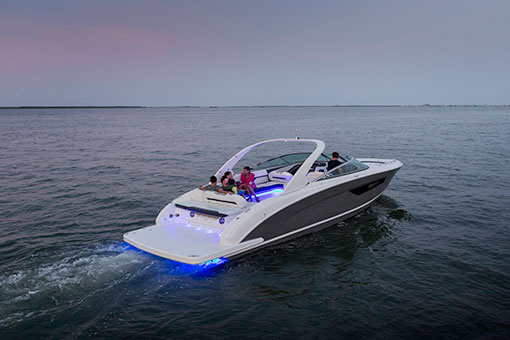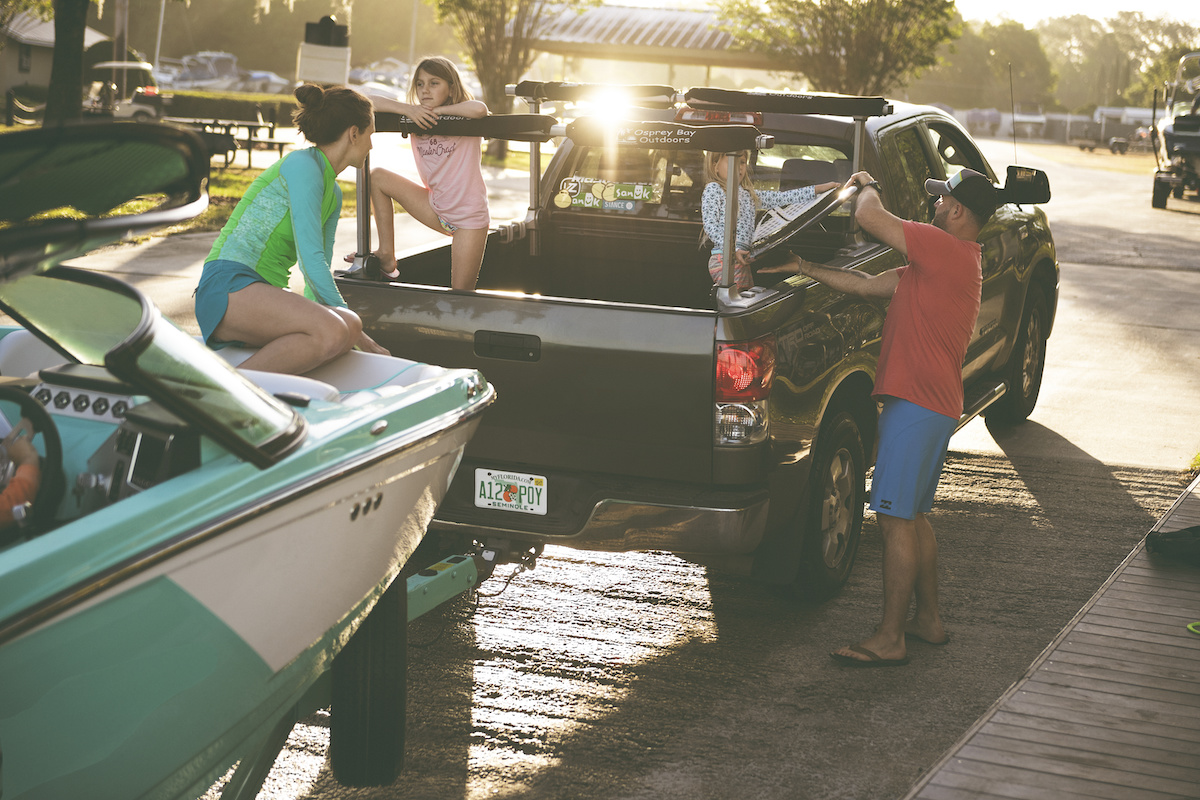1. If New, Get To Know
- If you’ve never used the ramp before, it’s worth the time to walk to the water’s edge and familiarize yourself:
- Is there a designated lane for launching or retrieving? This is common during weekends.
- Any debris at the water’s edge that could affect launching?
- Does the dock have cleats or just pilings to secure the dock lines?
- Find the end of the ramp so you’ll know not to back too far. If necessary, have someone stand there to warn if the trailer gets close to the ramps edge.
2. Load While Waiting
While waiting in line, unpack any items from the tow vehicle and put them in the boat (coolers, extra gas tanks, clothing, electronics, and equipment). Do it now instead of at the bottom of the ramp; otherwise, the people behind you will have to wait. This applies to either a single-lane or multiple lane boat ramp. This makes things move faster.
- Assign tasks that need to be completed during the launch.
- Attach bow and stern lines to the boat and keep the ends accessible to grab when needed at the water’s edg
- Remove children from the tow vehicle before backing down the ramp in the unlikely event something goes terribly wrong and the tow vehicle goes into the water.
- For the same reason, lower the vehicle’s windows to make a quick escape if the vehicle is immersed. Power windows may not work below the surface.
- Is the drain plug inserted in the transom?
- Untie the tie-downs.
3. One Lane – No Complain
If there are multiple lanes at the ramp, pick one. Avoid backing the trailer down the middle of the two lanes because this means nobody else can use this part of the ramp.
4. Eye On The Prize
Have someone stand at the water’s edge while the boat and trailer are backed down the ramp. This gives you an extra set of eyes and that person can tell you when the trailer has reached the appropriate depth of water at the ramp. If the ramp allows power loading (and power unloading), this person can also signal when the boat’s outdrive or outboard has reached the needed depth to operate.
5. Take It From The Top
In the event you make a mistake backing the trailer, it’s usually easier to go back to the top of the ramp and begin again rather than try and straighten the boat trailer in the middle of the ramp.
6. In The Water
When the boat is in the proper position to be launched, stop the tow vehicle, put it in park , and set the emergency brake. Many boaters will chock the rear wheels of the tow vehicle to keep it from rolling back should the brakes fail.
- Disconnect the winch cable from the bow eye.
- Lower the outdrive/outboard.
- If the ramp has two lanes, close the drivers-side and passenger doors so as not to affect anyone trying to back a trailer down in the next lane.
- Double-check the drain plug.
7. Dock It
Is power loading legal? Many boat ramps forbid this practice because the prop wash can erode the bottom. If you aren’t going to power load, one person shoves the boat off the trailer while a second person takes both the bow line and stern line and moves the boat to the end of the dock, leaving room for others waiting in line on the ramp and on the water. This is the time to have everyone at the dock ready to board the boat. Waiting for crew members who are in the nearby gift shop, bathroom, or store is only going to delay the departure.
8. Put It In Drive And Go
Unblock the tow vehicle, release the emergency brake, and move the tow vehicle up the ramp to a parking place. Don’t stop at the top of the ramp to adjust equipment. Do it when you’re parked.
9. Crowd Control
Two points on parking: First, if friends are meeting you at the boat ramp that is known for being crowded, consider an alternative site, like a nearby shopping center. This relieves parking problems at the ramp. Second, if folks do meet you at the ramp, make sure they don’t park in an area reserved for boat trailers and tow vehicles.
10. PFD For All
Are there enough life jackets for everyone? Remember the BoatU.S. Foundation Life Jacket Loaner Program (www.BoatUS.com/Foundation/ljlp) has life jackets available for children at a cooperating marinas, BoatU.S. Towing operator ports, U.S. Army Corps recreation sites, and many fuel docks offering BoatU.S. members at a discount.
Unplug the Lights?
Unplugging the trailer lights prior to backing down the ramp has been one of the great debates among trailer boaters for years. It began when incandescent bulbs were common on brake lights (they are still being manufactured) because the bulb would heat up whenever trailer brakes were applied and then burst when immersed in cold water during a launch – especially if the boat ramp was extremely long, as is the case in many Western states. Today, many new trailers use LED lights (light-emitting diode) that burn cooler, are sealed, and don’t need to be unplugged. Some lighting systems, however, connect the lights to the brakes in such a way that if the lights are unplugged, the brakes are too. So if incandescent, then unplug the lights – but remember to plug them back in when leaving the boat ramp. If LED keep them plugged in.

